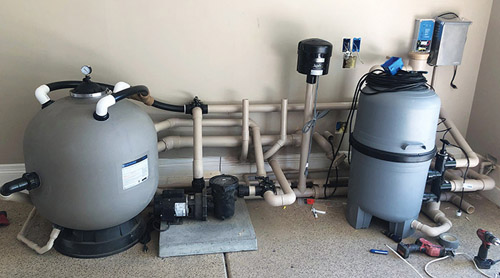
The most common pond size across the country is 2,000 gallons. Potential customers often call me asking, “How much will it cost to build a 2,000-gallon pond?” Unfortunately, this question can never be answered over the phone without further consultation.
So many factors are involved in making individual decisions about a specific design, including location, that make a phone quote both impossible and irresponsible.
Recently I received requests for two pond design consultations at the same time. The first was from Mike Newman of MAC Landscaping, and the second was from Hector Mardueno of Stonewall Creek. Each pond was just less than 2,000 gallons, and they had completely different designs. Naturally, each also had to be handled differently when it came to both filtration and design.
The first pond from MAC Landscaping was in a backyard immediately across the patio and had plenty of room behind the waterfall for filtration. The Stonewall Creek pond was a formal courtyard pond with no room for filtration within the limited space in the corner the customer had available.
[box style=”rounded”]Pond Construction | Best Practices | Raised, Formal Backyard Pond Design[/box]
MAC Landscaping’s Pond
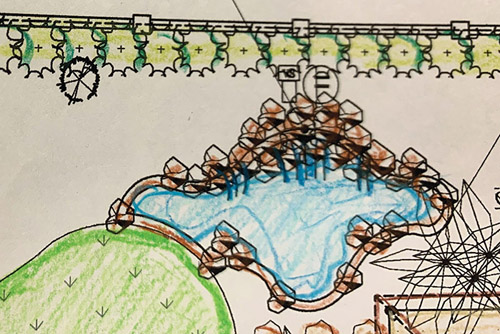
MAC Landscaping was redoing most of the backyard, and the shape and style of the pond came to me as a drawing taken from the overall backyard makeover plans. The waterfall was in the center, with each side of the pond as a slight bulge. At this volume, a 3-inch bottom drain with one skimmer was all that was necessary to handle the required turnover rate, but the shape would leave one of the ends with poor skimming and circulation. This was solved by adding a second skimmer and a slightly larger pump, which helped the overall flow, considering the waterfall was to be visually larger than the pond’s volume required.
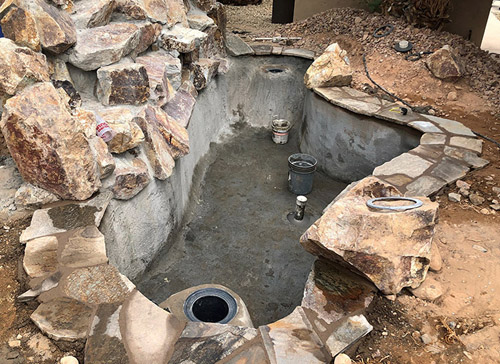
I’ve always leaned toward passive, gravity-flow, low-pressure systems, and they were ideal for this pond. We used one in-ground 55-gallon drum radial separator fed by a 3-inch bottom drain. I chose a WLim Wave 1 ¼-Horsepower pump, which flows just less than 6,000 gallons per hour at 9 feet of head. This provides enough to pull 2,000 gph from the bottom drain-prefilter circuit and 2,000 gph from each Aqua-Niche skimmer.
Biofiltration is handled by two 55-gallon drum upflow sand and gravel filters built into the waterfall. The diameter of each of the sand and gravel filters, at 22 ½ inches, restricts the flow rate to a maximum of 1,800 to 2,000 gph each. The balance of the water flow is diverted to a return jet opposite the waterfall and aimed toward the bottom drain. The 5-inch air diffuser disc on the bottom drain is powered by a V301 air pump at only 25 watts.
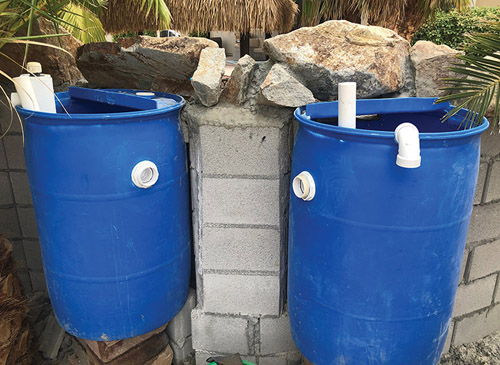
The LWS ultraviolet light assembly was installed in a downflow configuration inside one of the sand and gravel filters. When UV light housings are mounted in a downflow configuration,remember to vent them at the top to release any trapped air that accumulates over time.
The autofill was installed inside the radial separator tank, hiding it from view. This setup formed a neat package hidden behind the waterfall. The concrete surface inside the pond was sealed with Hydro Ban by Laticrete, and the waterfall was sealed with EPDM rubber liner. Mike’s crew has built many water features before, but this was their first dedicated koi pond. With just a little bit of guidance, they managed it perfectly.
Stonewall Creek’s Pond
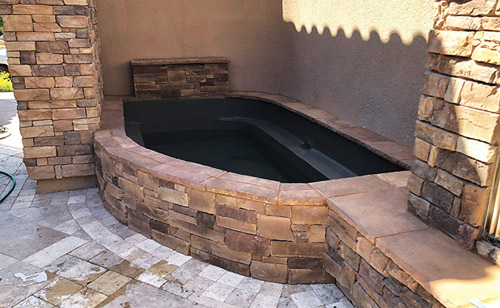
wall.
Stonewall Creek’s pond had no plans to start with — just a space where the client wanted it built. I met with Hector and the homeowner on-site and saw that it was walled in on three sides next to a fireplace. The space had a few plants and a small tree that would have to be removed. We decided on a raised pond that matched the height of the fireplace hearth.
The front raised edge would match the existing curve of the paver patio where it bordered the small garden. Hector would have to find both faux stone block that matched the original fireplace face and a top cap that matched the fireplace hearth. This sort of thing can be a challenge several years after the initial construction, because trends in faux stone surfaces and colors change with the times.
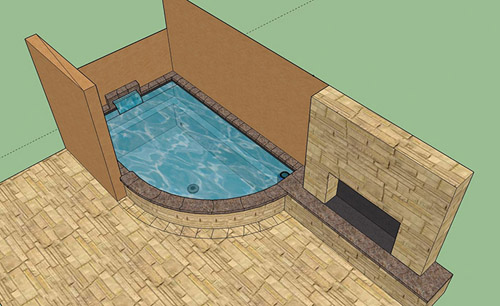
With no space inside the pond area and no way to gravity flow any of the plumbing, the filtration would have to be remote and pressurized. Luckily, the wall on the right side of the pond was also the wall of the garage.
There was enough space between the wall and the garage doors to fit some filtration. The client decided on a low spill along the backside as a visual water feature. With these criteria in mind, I created a 3-D SketchUp drawing for everyone to approve before the work started.
The pond design started with a 3-inch bottom drain and one Aqua-Niche in-pond skimmer. For prefiltration, I built a smaller version of my Static Suction Prefilter and coupled it with my Low-Pressure Bioreactor.
The pump returns water through the spill and two 1 ½-inch returns. One 4-inch, 57-watt UV light was installed in the circuit with a bypass. A 45-LPM Medo air pump powers the bottom drain air diffuser, and a WLim 1/3-Horsepower pump operates the system. The pump needed to be larger than the required filtration because of the pressure needed for the LED-lighted spill the client had decided on. Two small LED lights located in the end opposite the spill completed the lighting package, and the autofill was an electronic Levelor system. The pond’s interior was sealed with spray-applied Polyurea installed by Paul Parszik of Artisan Aquatics.
Ballpark Quotes
In summary, these two ponds are prime examples of polar opposite designs based on the same 2,000-gallon volume.
Remember when I said to “never” provide a quote based on size alone? In some cases, you might have to give a customer a general idea of what they can ultimately expect to spend. So, attempt to calculate a range based on your previous jobs and, at best, quote a range. A good habit is to go through your previous invoices and calculate a cost-per-gallon ratio that fits your construction style and expenses.
For example, you might quote a range of $8 — 12 per gallon depending on all the factors involved. This range will obviously vary among contractors, but at least you can get an initial conversation started and qualify a price range based on the pond size the new customer is willing step into, regardless of the ultimate design.

